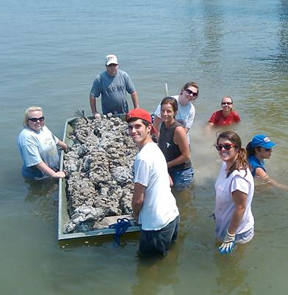 The Choctawhatchee Basin Alliance is seeking volunteers to help bag and build oyster reefs on Nov. 10, 14, 21. 2015. The project will be from 9 a.m. – 1 p.m.
The Choctawhatchee Basin Alliance is seeking volunteers to help bag and build oyster reefs on Nov. 10, 14, 21. 2015. The project will be from 9 a.m. – 1 p.m.
You will be bagging oyster shell at the South Walton Center of Northwest Florida State College, 109 Greenway Trail, Santa Rosa Beach. You will travel (about 5 miles) as a group to place bagged oyster shell in the water at a park nearby in Santa Rosa Beach, FL. Some transportation to reef site is available. We will be walking through waist deep water with a muddy bottom to get to the reef site so please wear appropriate clothing. Waders will be available in limited supply in case of cold weather.
What to bring/wear: Wear Clothes and close-toed shoes that you don’t mind getting dirty and wet. Bring a towel, sunscreen, and bug spray. Bring refillable water bottle and snacks. Gloves and water will be provided.
Please RSVP for any of these dates to: Rachel Gwin at Gwinr@nwfsc.edu.
Choctawhatchee Basin Alliance (CBA) is a non-profit watershed organization that is committed to providing education and experiences that empower citizens to take personal responsibility for the health and sustainable use of the Choctawhatchee Basin watershed. Our efforts fall into four main programs: Education, Monitoring, Research and Restoration. Oyster habitat construction is one of the main components of our Restoration program. Oysters are a natural filtration system for the Bay, helping to keep water clean, while the oyster reef structure provides habitat for other marine creatures and sediment stabilization that can help prevent erosion.
Oyster habitat in Choctawhatchee Bay has been diminished over the years by channel dredging and natural events, such as hurricanes, that have destroyed or removed oyster reef structure from the Bay. The loss of the oyster reefs leaves new oysters without a place to settle and grow. To provide for oyster habitat, CBA is replacing reef structure by placing bagged oyster shell at permitted sites around the Bay. New oysters settle on the bagged shell and the structure then becomes a thriving oyster reef.
We have had a lot of success with our oyster reef restoration program, and we could not have done it without the help of volunteers.
